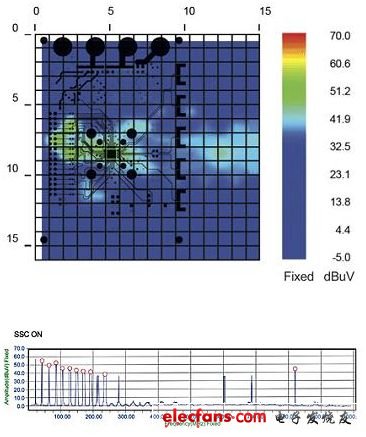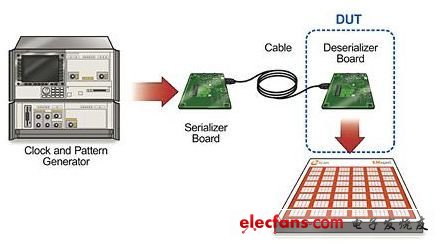Very near-field EMI scanning technology for automotive electronic systems
Industry-leading TEMPO evaluation service High segmentation capability, high-performance chip fuse products designed for OEM designers and engineers Samtec connectors Complete signal source New products every day New experience Full 15A switch mode power supply Global certification high Performance SMD Fuse FRAM Ferroelectric Non-Volatile Random Access Memory Automobile manufacturers often use the latest consumer electronics system to reflect the difference with other manufacturers' cars. The system must work properly under various harsh conditions. Power systems, safety systems, and other automotive control systems all have the same requirements. Once a failure occurs, these systems will cause more serious consequences. Automotive electronic systems are particularly sensitive to electromagnetic radiation from chips and printed circuit boards provided by suppliers. Therefore, SAE (formerly Association of Automotive Engineers) has defined test specifications and established requirements to meet electromagnetic compatibility (EMC) and electromagnetic interference (EMI), and has continuously improved them. Using the very near-field EM scanning technology, the supplier ’s design team can measure and immediately display the spatial and spectral characteristics of radiation through a desktop system to avoid future problems in higher-cost module, system or vehicle-level tests. This article discusses several examples that can demonstrate the value of such testing. The first example is about the radiation characteristics of the “spread spectrum clock generator (SSCG)â€, which are scanned under the “off†and “on†conditions, respectively. In the second example, the design team compared the second-generation half-duplex serial deserializer (serializer / deserializer) system with the third-generation full-duplex system. The results validate the new generation of features and their advantages, which not only helps customers shorten time to market, but also has a positive impact on customers. Very near-field EMI scanning technology Fast magnetic near-field measuring instruments can capture and display visual images of spectrum and real-time spatial scan results. Chip manufacturers and PCB design engineers can scan any circuit board and identify constant or time-based radiation sources in the 50kHz to 4GHz frequency range. This scanning technique helps quickly solve a wide range of electromagnetic design issues, including filtering, shielding, common mode, current distribution, anti-interference, and broadband noise. In the development of any new PCB, the design engineer must find radiators or RF leaks outside the design, and describe and deal with them to pass the conformance test. Possible radiators include high-speed, high-power devices and devices with high density or complexity. The scanning system displays the spatial radiation characteristics in a form superimposed on the Gerber file, so the tester can accurately find the source of all radiation problems. The design engineer can re-test the device after taking corresponding measures and immediately quantify the effect after correcting the design. The scanning system consists of a scanner, a small adapter, a customer-provided spectrum analyzer, and a PC running the scanning system software. The desktop scanner includes 2,436 loops, which can generate 1,218 magnetic field probes at 7.5mm intervals, forming an electronic switch array and providing resolutions up to 3.75mm. The operating frequency range of the system is 50kHz to 4GHz, which is enabled by an optional software key. In this way, users can test the design themselves without having to rely on another department, test engineer, or perform time-consuming off-site testing. Engineers can even make changes to the design after diagnosing an intermittent failure, and then test again soon. The test results can accurately verify the impact of design changes. With the help of the scanning system, circuit board design engineers can test and solve electromagnetic compatibility problems in advance, thus avoiding unintended conformance test results. The diagnostic capabilities of the scanner can help the design team shorten the radiation test time by more than two orders of magnitude. EMI near-field radiation characteristics: SSCG example A large semiconductor manufacturer implemented the SSCG function on the parallel bus of the deserializer. The SSCG function can reduce radiation by extending the peak energy of radiation to a wider frequency band. As shown in Figure 1 below, the frequency change occurs near the center frequency of the rated clock (center spread spectrum modulation), and the spread spectrum is positive or negative 1.0% (fdev). On the parallel bus side of the receiver, the output modulates the clock frequency and data spectrum with time at a modulation rate of kilohertz (fmod). The target customers of the customized serial deserializer chipset are automotive manufacturers who require the installed electronic equipment to have low EMI radiation characteristics. Figure 1: Spread spectrum clock function. The company expects to use convincing quantitative evidence to explain to automakers that the SSCG function can effectively reduce EMI emissions. To achieve this goal, the design team first placed the device under test (DUT) on its internal scanner with the SSCG function turned off, powered on, and then captured the radiation characteristics in the PC. For effective comparison, the same device under test was scanned with the SSCG function turned on. The near-near field scanning system displays and generates the following radiation characteristic map after completing the spatial and spectral scanning. It should be noted that the scan results are superimposed on the Gerber design file, so the analysis of the results can immediately determine the specific radiator in the device under test. Figure 2 shows the radiation characteristics of the device under test when the SSCG function is “offâ€. Figure 2: EMI radiation characteristics measured when the SSCG function is "off". Figure 3 shows the spatial and spectral (amplitude and frequency) characteristics of the device under test when the SSCG function is "on". By comparison, it can be found that the radiation has been significantly reduced. Figure 3: EMI radiation characteristics when the SSCG function is "on". After comparing the test results, the design team found that the electromagnetic radiation was significantly reduced due to the use of the SSCG function. The biggest challenge for automotive electronics engineers is to reduce EMI radiation. Every time the customer support team presents these results to automaker customers, they generally show great interest. Any function that reduces EMI (SSCG function in this case) can shorten time to market, reduce shielding and cost. EMI near-field radiation characteristics: an example of a new generation of serial deserializers This is the second example of the same semiconductor supplier. The company has developed a second-generation chipset solution for point-to-point transmission through a serial deserializer. In the third-generation chipset, the design team adopted a different technology and upgraded transmission capabilities. They embed the two-way control channel together in the high-speed serial link, thereby achieving two-way transmission (full duplex). In order to quantify and compare the radiation characteristics of the half-duplex deserializer and the new-generation full-duplex design, the design team again used an internal EMI extremely near-field scanner. They placed the original half-duplex board on the scanner and made a baseline measurement. After powering on the device under test, they activated the scanner on the PC. (See Figure 4) Figure 4: Test environment for EMI scanning of half-duplex and full-duplex serial deserializer devices. Using the same test setup, the design team replaced the baseline board with a new generation of full-duplex chipset boards, while maintaining the same specifications for each feature. As mentioned above, it should be noted that the spatial scan is superimposed on the Gerber design file generated each time to help the engineer determine any existing radiation sources. Dc Bench Power Supply,Variable Dc Power Supply,Adjustable Dc Power Supply,Regulated Dc Power Supply Yangzhou IdealTek Electronics Co., Ltd. , https://www.idealtekpower.com


